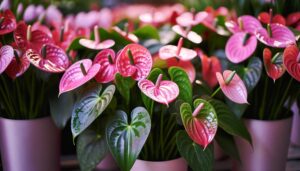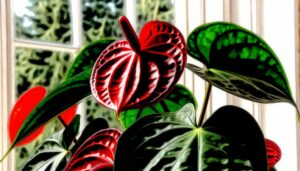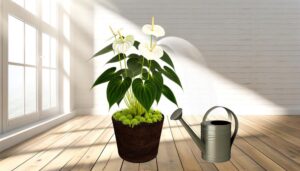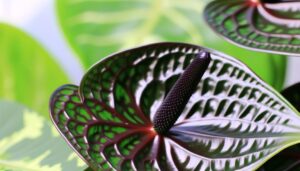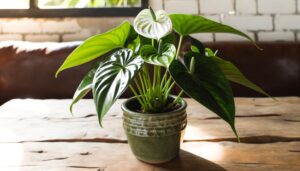Why Are Red Anthurium Leaves Turning Yellow?
Your red anthurium leaves might be turning yellow due to several factors. Overwatering can cause root rot, while underwatering disrupts nutrient absorption.
Improper light conditions, like excessive or insufficient light, can hinder photosynthesis. Temperature fluctuations can shock the plant, affecting leaf health.
Low humidity levels below 60% can lead to dehydration. Nutrient deficiencies, particularly in nitrogen, magnesium, and iron, cause yellowing.
Pests such as spider mites and fungal infections like leaf spot can also be culprits. Ensuring prime care by addressing these issues will help keep your anthurium healthy and vibrant.
Discover more detailed solutions to these problems next.
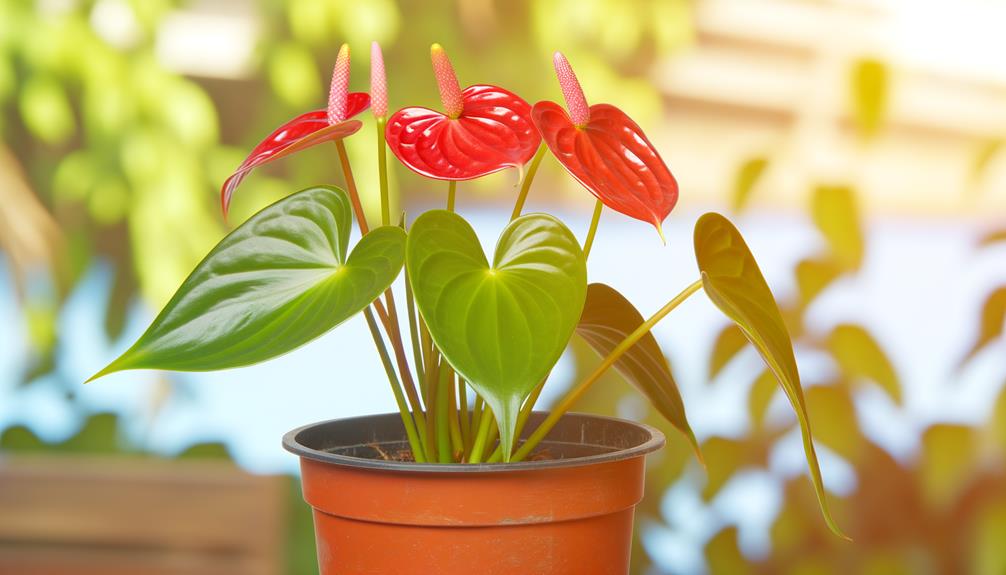
Key Takeaways
- Overwatering can cause root rot and suffocate roots, leading to yellowing leaves.
- Insufficient light or sudden temperature changes can shock anthuriums, resulting in yellowing leaves.
- Low humidity levels can dehydrate the plant, causing leaves to turn yellow.
- Nutrient deficiencies, particularly in nitrogen, magnesium, and iron, can result in yellowing leaves.
- Pest infestations and fungal infections can cause leaves to turn yellow.
Overwatering Issues
When you overwater your anthurium, the excess moisture can suffocate the roots, leading to root rot and the subsequent yellowing of the leaves. Root rot is caused by a lack of oxygen in the soil, which inhibits the roots' ability to absorb essential nutrients.
As a result, the plant's overall health diminishes, and its leaves start to turn yellow. To identify overwatering, check for soggy soil or a noticeable musty smell. Evidence suggests that proper drainage and a well-aerated potting mix are essential for maintaining healthy roots.
Make sure you're allowing the top inch of soil to dry out between waterings. By monitoring moisture levels and adjusting your watering routine, you can prevent root rot and keep your anthurium vibrant.
Underwatering Problems
You'll notice yellowing leaves on your Red Anthurium when soil moisture is insufficient, which disrupts nutrient absorption.
Dry environmental conditions exacerbate this issue, leading to further dehydration of the plant.
An infrequent watering schedule compounds the problem, causing chronic stress and visible symptoms in the foliage.
Insufficient Soil Moisture
Underwatering is a frequently overlooked issue that can cause red anthurium leaves to turn yellow due to insufficient soil moisture. When the soil lacks adequate moisture, your anthurium struggles to absorb essential nutrients, leading to chlorosis and eventual leaf yellowing. You'll want to maintain a consistent watering schedule to sustain ideal soil hydration.
Here are four signs that your anthurium may be suffering from insufficient soil moisture:
- Wilting leaves: The leaves appear droopy and lifeless.
- Crispy leaf edges: Browning and crisping at the leaf margins.
- Slow growth: Stunted development and limited new leaf production.
- Soil shrinkage: Soil pulling away from the pot edges, indicating dryness.
Addressing these signs promptly ensures your anthurium remains healthy and vibrant.
Dry Environmental Conditions
Dry environmental conditions exacerbate the problem of underwatering by accelerating soil moisture loss and stressing anthurium plants, leading to yellowing leaves. When ambient humidity drops, transpiration rates increase, causing the plant to lose water more rapidly through its leaves.
This desiccation disrupts cellular turgor pressure, resulting in chlorosis. Scientific studies confirm that anthuriums thrive in humidity levels between 60-80%. Deviations below this threshold impair physiological processes, including photosynthesis and nutrient uptake. You might notice the leaf margins curling or browning before they turn yellow.
Additionally, a dry environment can lead to compacted soil, hindering root absorption efficiency. To mitigate these issues, consider using a humidifier or placing a water tray near your plant to elevate local humidity levels.
Infrequent Watering Schedule
An infrequent watering schedule greatly contributes to the yellowing of anthurium leaves by disrupting the plant's cellular hydration balance and nutrient transport mechanisms. When you don't water consistently, anthuriums can't maintain the turgor pressure needed for cell rigidity, leading to flaccid, yellowing leaves.
This imbalance also hampers the efficient uptake and transport of essential nutrients, exacerbating the yellowing process.
Consider these crucial aspects:
- Stress Response: Infrequent watering induces physiological stress, weakening your plant.
- Nutrient Deficiency: Irregular watering leads to nutrient lockout, making it harder for roots to absorb essential minerals.
- Root Damage: Prolonged dryness can cause root desiccation, impairing their function.
- Growth Inhibition: Water stress severely inhibits growth, stunting your beloved anthurium's development.
Consistent care is key.
Improper Light Conditions
Inadequate lighting, either excessive direct sunlight or insufficient exposure, can stress anthurium plants to a significant extent, leading to yellowing leaves. Direct sunlight can burn the leaves, while low light levels hinder photosynthesis, compromising the plant's health. To diagnose, observe the leaf color and placement within your space.
| Light Condition | Symptom | Remedy |
|---|---|---|
| Excessive Sunlight | Scorched leaves | Relocate to indirect light |
| Insufficient Exposure | Pale, yellow leaves | Move to brighter, filtered light |
| Ideal Light Condition | Vibrant red leaves | Maintain placement, monitor light |
Ensure your anthurium receives bright, indirect light for best growth. Analyzing light conditions meticulously ensures you maintain the vibrant health of your plant.
Temperature Fluctuations
Sudden temperature changes can shock anthurium plants, leading to yellowing leaves as the plant struggles to adapt. Consistency is vital for maintaining their vibrant red foliage. When exposed to temperature fluctuations, anthuriums experience cellular stress, which disrupts nutrient absorption and photosynthesis.
Here's how fluctuating temperatures can impact your cherished plant:
- Cold Drafts: Brief exposure to cold air can cause immediate leaf yellowing.
- Heat Spikes: Sudden increases in temperature can lead to leaf burn and eventual yellowing.
- Night-Day Variations: Extreme temperature differences between day and night can stress the plant.
- Improper Placement: Positioning near vents or windows can subject your anthurium to inconsistent temperatures.
Humidity Levels
You need to maintain a best humidity range of 60-80% for your red anthurium to prevent yellowing leaves.
Low humidity levels can lead to dehydration, causing chlorosis and subsequent leaf yellowing.
To increase humidity, consider using a humidifier, placing a water tray near the plant, or misting the leaves regularly.
Optimal Humidity Range
Maintaining an ideal humidity range between 60% and 80% is important for preventing red anthurium leaves from turning yellow. You'll need to monitor and adjust your home's humidity levels to keep your anthurium thriving. The best range supports transpiration and nutrient uptake, which are vital for vibrant foliage.
Here's why:
- Enhanced Photosynthesis: Proper humidity ensures that stomata remain open, facilitating gas exchange.
- Efficient Water Use: High humidity reduces water loss through transpiration, keeping leaves hydrated.
- Disease Prevention: Balanced humidity minimizes the risk of fungal infections.
- Stress Reduction: Consistent humidity levels prevent environmental stress that can lead to yellowing.
Effects of Low Humidity
When humidity levels drop below 60%, anthurium leaves can start yellowing due to increased transpiration rates and subsequent water stress. Lower humidity accelerates moisture loss from leaf surfaces, forcing the plant to draw more water from its roots. This imbalance disrupts nutrient uptake, leading to chlorosis, or yellowing, as essential nutrients like nitrogen and magnesium become deficient.
Scientific studies show that anthuriums thrive in environments where relative humidity is consistently high. A drop in humidity compromises the plant's ability to maintain turgor pressure, essential for nutrient transport.
You'll notice the leaves turning yellow, curling at the edges, and even developing brown tips. By understanding this physiological response, you can better cater to your anthurium's needs and prevent such stress-induced symptoms.
Increasing Humidity Methods
To effectively increase moisture levels for your anthurium, consider utilizing methods like pebble trays, misting, and the use of humidifiers. These techniques can maintain the best humidity range of 60-80%, essential for your plant's well-being. Employing a hygrometer to monitor humidity levels ensures accuracy.
- Pebble Trays:
Position your anthurium pot on a tray filled with water and pebbles. This creates a micro-environment with higher moisture.
- Misting:
Regularly spray your anthurium, but avoid over-saturating the leaves, which can lead to fungal issues.
- Humidifiers:
Invest in a quality humidifier to consistently maintain ideal moisture levels.
- Grouping Plants:
Cluster your anthuriums with other plants to naturally boost ambient humidity through transpiration.
Implementing these methods will strengthen your anthurium against yellowing leaves.
Nutrient Deficiency
One essential cause of yellowing in red Anthurium leaves is a deficiency in necessary nutrients like nitrogen, magnesium, and iron, which are pivotal for chlorophyll production and overall plant health.
When your Anthurium lacks nitrogen, you'll notice older leaves turning yellow first while younger leaves remain green.
Magnesium deficiency often manifests as interveinal chlorosis, where the leaf veins stay green but the tissue between them turns yellow.
Iron deficiency, on the other hand, usually affects new leaves, making them yellow with green veins.
To address these nutrient deficiencies, you should consider using a balanced, water-soluble fertilizer that includes micronutrients. Regular feeding can help maintain the best nutrient levels, ensuring your plant's leaves stay vibrant and healthy.
Soil Quality
You need to make sure your anthurium's soil has the right balance of nutrients and moisture. Poor soil quality can lead to nutrient deficiencies, causing the leaves to turn yellow.
Additionally, improper soil moisture levels can stress the plant, exacerbating leaf discoloration.
Nutrient Deficiency Effects
Over time, nutrient deficiencies in the soil can lead to yellowing leaves in red anthuriums, indicating a significant imbalance in essential minerals. Nitrogen, phosphorus, potassium, and magnesium are essential for ideal growth. When these nutrients are lacking, your anthurium's health suffers. Consider these impacts:
- Nitrogen Deficiency: Causes chlorosis, leading to pale, yellow leaves.
- Phosphorus Deficiency: Results in dark, dull leaves and stunted growth.
- Potassium Deficiency: Leads to leaf edge browning and yellowing.
- Magnesium Deficiency: Causes interveinal chlorosis, where leaves turn yellow but veins remain green.
Addressing these deficiencies with a balanced fertilizer can rejuvenate your plant. Monitoring and adjusting soil quality ensures your red anthurium thrives, maintaining its vibrant beauty.
Soil Moisture Levels
Proper soil moisture levels are crucial for maintaining the health of red anthuriums, as both overwatering and underwatering can lead to yellowing leaves. When soil remains waterlogged, oxygen availability decreases, causing root rot and impaired nutrient uptake.
Conversely, dry soil stresses the plant, hindering its ability to transport water and nutrients effectively. Utilize a well-draining potting mix, typically containing peat, pine bark, and perlite, to manage moisture levels efficiently.
Regularly check the soil's moisture by inserting your finger about an inch deep; it should feel slightly damp but not wet. Equip your pot with adequate drainage holes to prevent water accumulation.
Maintaining balanced soil moisture ensures optimal root health and prevents the yellowing of anthurium leaves due to stress.
Pest Infestation
A common cause of yellowing leaves in red anthuriums is pest infestation, often involving spider mites, aphids, or mealybugs that damage the plant by feeding on its sap. These pests can cause chlorosis, leading to a significant reduction in photosynthetic capabilities. You might notice tiny webs, sticky residue, or small white insects.
To address this, consider the following steps:
- Inspect Regularly: Closely examine the undersides of leaves and stems for early signs.
- Isolate Affected Plants: Immediately separate infested plants to prevent spreading.
- Apply Insecticidal Soap: Use organic insecticidal soap to treat affected areas.
- Maintain Humidity: Increase humidity around your plants, as dry conditions favor pest proliferation.
Fungal Infections
When yellowing leaves appear on your red anthurium, fungal infections such as root rot or leaf spot are often to blame, necessitating immediate and precise intervention to prevent further damage.
Root rot typically manifests when your plant's roots are consistently waterlogged, leading to fungal proliferation. You'll notice yellowing leaves, a foul odor, and mushy roots.
Leaf spot, caused by pathogens like Colletotrichum or Myrothecium, presents as yellowing foliage with dark, necrotic spots.
To combat these issues, reduce watering frequency, improve soil drainage, and guarantee adequate air circulation. Apply a fungicide specifically labeled for anthuriums.
Quarantine infected plants to prevent spread. Vigilance and prompt action are essential to restoring your anthurium's vibrant health.
Aging Leaves
Noticing yellowing leaves on your red anthurium can often be attributed to the natural aging process, where older foliage gradually loses its energy and color. This phenomenon occurs as the plant reallocates resources to newer growth, prioritizing essential.
To differentiate aging from other issues, observe these signs:
- Lower leaves turning yellow first: Aging typically affects the older, lower leaves.
- Gradual yellowing: Unlike rapid yellowing from pests or diseases, aging leaves yellow slowly.
- Absence of spots or lesions: Aging leaves usually lack the blemishes seen in diseased foliage.
- Normal plant growth: New leaves remain vibrant and healthy, indicating the plant's overall well-being.
Understanding these indicators helps you ensure your anthurium continues to thrive despite the natural lifecycle of its leaves.
Conclusion
To sum it up, your red anthurium leaves are turning yellow due to various factors such as overwatering, underwatering, improper light, temperature fluctuations, humidity, soil quality, pests, fungal infections, and natural aging.
Addressing these issues is crucial to restore your plant's vitality. Remember, fixing your anthurium isn't brain surgery; it's more like troubleshooting a vintage radio—identify the problem and adjust accordingly.
Stay observant and proactive, and your anthurium will thrive again.

